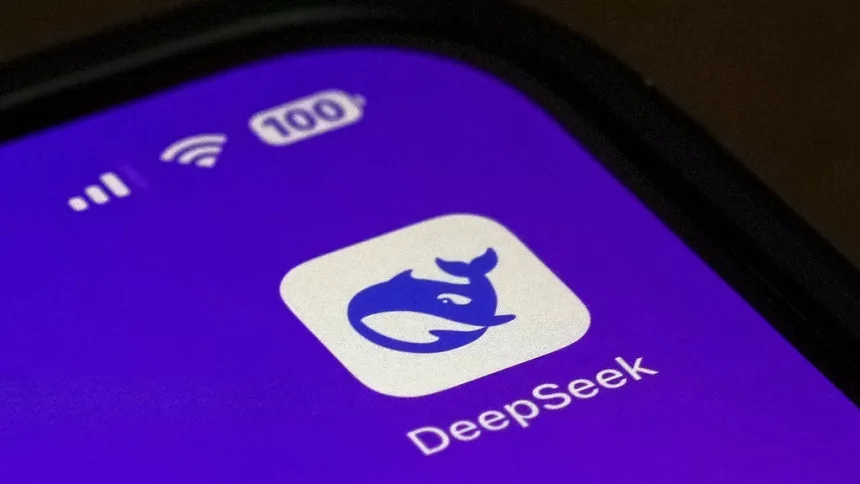A surge in interest surrounding an artificial intelligence chatbot created by Chinese tech startup DeepSeek disrupted stock markets on Monday and ignited debates about the economic and geopolitical competition between the U.S. and China in AI development.
DeepSeek’s AI assistant became the top free app on Apple’s iPhone store, fueled by public curiosity about its potential as a competitor to ChatGPT. Concerns have arisen in the U.S. tech industry over whether the Chinese startup has achieved technological parity with American firms at a fraction of the cost.
If proven, this development raises questions about the substantial investments U.S. tech companies are making in data centers and high-performance chips for AI advancements.
However, some analysts caution against overstating DeepSeek’s progress.
“The models they built are fantastic, but they aren’t miracles either,” said Stacy Rasgon, a Bernstein analyst specializing in semiconductors. “They’re not using any innovations that are unknown or secret or anything like that. These are things that everybody’s experimenting with.”
DeepSeek’s Journey and Innovations
Founded in 2023 in Hangzhou, China, DeepSeek introduced its first large language model that same year. Its CEO, Liang Wenfeng, previously co-founded High-Flyer, a leading Chinese hedge fund specializing in AI-driven quantitative trading.
By 2022, High-Flyer had accumulated 10,000 of Nvidia’s high-performance A100 graphics processor chips to build AI systems, according to a WeChat post. Shortly afterward, the U.S. restricted sales of those chips to China. DeepSeek has since utilized Nvidia’s H800 chips, which remain legal for export to China, demonstrating that cutting-edge AI research may not require the most advanced hardware.
DeepSeek gained further attention last month with the release of a new AI model it claimed rivaled models from U.S. companies like OpenAI. Notably, the system was developed more cost-effectively, leveraging Nvidia chips to train on extensive datasets. The AI assistant’s popularity surged after its release on Apple and Google app stores.
Last week, DeepSeek published a follow-up research paper introducing its R1 model. The model showcased advanced reasoning abilities, such as rethinking its approach to solving math problems, while being significantly cheaper than OpenAI’s o1 model.
“What their economics look like, I have no idea,” said Rasgon. “But I think the price points freaked people out.”
Geopolitical Implications and Industry Impact
The growing prominence of DeepSeek has intensified discussions about U.S.-China competition in AI. Venture capitalist Marc Andreessen described DeepSeek’s advancements as “AI’s Sputnik moment,” comparing it to the Soviet Union’s 1957 satellite launch that triggered the Cold War space race.
Andreessen has cautioned that overregulation of AI in the U.S. could hinder American companies and provide China with a competitive edge.
Experts also noted the strategic timing of DeepSeek’s announcement. Gregory Allen, director of the Wadhwani AI Center at the Center for Strategic and International Studies, suggested that the timing was politically motivated. He compared it to Huawei’s 2023 unveiling of a new smartphone during discussions about U.S. export controls.
“Trying to show that the export controls are futile or counterproductive is a really important goal of Chinese foreign policy right now,” Allen said.
Political and Market Reactions
Former President Donald Trump weighed in on the matter, describing DeepSeek’s progress as “good because you don’t have to spend this much money.” Speaking to House Republicans in Miami, Trump called the development a “wake-up call” for U.S. industries to prioritize global competition.
On his first day in office last week, Trump signed an order to identify and eliminate loopholes in export controls, signaling a continuation of restrictive policies on AI-related technologies.
Nvidia’s stock fell by 17% on Monday amid market jitters. However, the company praised DeepSeek’s efforts, calling them “an excellent AI advancement” that used “widely-available models and compute that is fully export control compliant.”
What Sets DeepSeek Apart?
Unlike competitors such as OpenAI, DeepSeek’s models are open source, allowing others to access and modify their core components. However, the company has not disclosed the datasets used for training.
DeepSeek’s R1 model has earned recognition for its use of “Test Time Scaling,” which allows the AI to improve its performance by analyzing its reasoning process without requiring new data.
“It’s just thinking out loud, basically,” said Lennart Heim, a researcher at Rand Corp.
While U.S.-based companies like OpenAI and Anthropic possess similar capabilities, DeepSeek’s rapid advancements have captured attention.
“It’s the first time we see a Chinese company this close within a short time period,” Heim said. “I used to believe OpenAI was the leader, the hill’s king, and nobody could catch up. Turns out this is not completely the case.”















